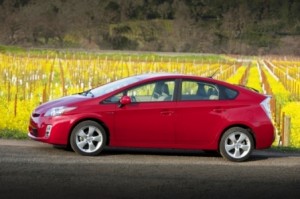Fuel prices are up and closing on record levels, but U.S. hybrid sales have slumped to their lowest level s in 16 months, with few signs of any imminent improvement.
Put much of the blame on the March 11 disaster in Japan that has led to a massive drop in production of key models like the Toyota Prius, the world’s best-selling hybrid, industry analysts suggest. But soaring prices may have also been a factor.
That’s one reason why, even with a more normal supply, hybrids could continue losing ground. There are now plenty of high-mileage alternatives on the market using diesel as well as more conventional gasoline powertrains, the latter not saddled with the hefty premium typical of hybrid vehicles.
“For those selling hybrids, it is incredibly bad luck that the Japanese earthquake and associated production disruptions occurred as gas prices were reaching their highest levels in three years,” said Lacey Plache, the chief economist at Edmunds.com.
The March 11 earthquake and tsunami virtually shut down the Japanese auto industry for a month. Since then, however, production has been running well below normal, especially in the home market, the only source of many key hybrids, like the Prius. “Real and imagined supply constraints” appear to have been a key factor in the May hybrid sales slump, according to Plache.
Gas-electric models from Toyota and its sibling Lexus division plunged 45.1% last month, the Prius itself off 51%, Toyota selling just 6,924 of them in May. Honda, which ranks second on the hybrid sales charts, suffered a 29% drop in demand.
All told, American motorists bought fewer hybrids in May than they did the three key domestic muscle cars: the Ford Mustang, Chevrolet Camaro and Dodge Challenger.
But availability isn’t the only factor, some analysts suggest. Data from TrueCar.com indicates that dealers were charging almost $3,000 more for a Prius in May than they got just three months earlier. That reflects not only a shortage-driven premium but also the decision by Toyota to curb incentives across its product range. The maker also had enacted a roughly 2% price hike at the beginning of May.
The world’s largest automaker has since announced plans to boost incentives. It has also placed a premium on restoring production of the Prius and other hybrids, even at the expense of other models.
But observers warn it may be difficult to regain momentum. The bump in muscle car sales suggests, for one thing, that car buyers are getting past the initial shock of $4 gas. Indeed, a look at historic sales data shows that by July 2008 – just before fuel prices hit their all-time peak – demand for hybrids and other small cars was peaking, with sales of pickups, SUVs and other less economical offerings starting to bounce back.
“While Japanese automakers may well gain back their lost share on other vehicles, hybrids will face an even steeper climb back to previous levels, given the greater and growing competition from fuel-efficient, non-hybrid vehicles,” cautioned Edmunds Plache.
There are already eight conventional, gasoline-powered models in the so-called “40 MPG Club,” including the Ford Fiesta and Hyundai Elantra, she noted, with more coming. Chrysler, for example, has promised to bring out a model of its own by year-end.
A full 35 models deliver better than 30 mpg in the EPA’s Combined City/Highway ratings test, including some midsize and crossover offerings.
Whether makers can overcome the hybrid slump could depend on just how much higher fuel prices go, analysts conclude.

